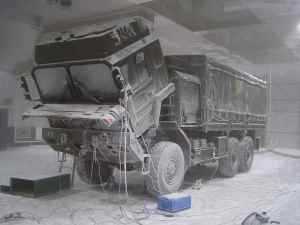
QinetiQ has just completed a series of rigorous environmental trials on 12 different types of MAN military logistic trucks in its test chambers at MOD Boscombe Down, part of an independent 18-month evaluation contract for the new supply vehicles fleet for the MOD’s General Support Vehicles IPT.
Over three separate six-week phases, the 12 vehicle types have been subjected to temperatures of between +49°C and -46°C to ensure reliable operation. The first simulated desert hot / dry conditions going to +49°C with solar levels for a typical day cycle reaching 1120 watts per metre square. The second phase created tropical hot / wet conditions at around +40°C but with relative humidity levels of 80%.
The final phase saw temperatures plunge to recreate Arctic temperatures of -46°C for specially prepared winterised vehicles and a chilly -32°C for the standard fleet During each of the phases every piece of equipment, on each of the vehicles, was regularly tested to ensure it functioned consistently in the various conditions. This included engine starts and crew heating and cooling systems, right down to operating the wiper blades and brakes. All ancillary items including winches, pumps and cranes were similarly tested to the same exacting standards. Further testing is planned in early 2008 on the winterised variant.
In addition to testing military and other land vehicles, QinetiQ’s climatic environment chambers can accommodate other similarly large equipment including large commercial road and rail vehicles plus can simulate the conditions aircraft, their systems and the aircrew regularly experience.
QinetiQ’s main temperature control chamber measures 24.5m x 25m x 5.4m high with a 6.75m high recess for aircraft fins. Environmental conditions can be constantly controlled between +70°C to -70°C. Humidity control is between ambient and 95% ±5% Relative Humidity (RH) at +40°C and sun effect (using solar arrays) are available throughout most of the temperature range. A second temperature control chamber measuring 5m x 4m x 7.5m is also available with similar humidity and sun-effect control. The size of the large chamber also means that a number of pieces of equipment may be tested simultaneously – for example a small fleet of vehicles. In addition the facility can host habitability trials where the man to vehicle interface and survivability can also be examined.
The environmental chambers can be used for checking electrical and hydraulic systems using ground test rigs and supply of cold air to run auxiliary power units. Propellers (but not rotors) can also be run continuously while maintaining the test environment. Exhaust gases can be ducted to the outside of the building allowing trials to be conducted with Auxiliary Power Units (APUs) and engines running. Layers of ice can also be applied to the test equipment within the chamber to check its operation under icing conditions.
The military logistic vehicle supply contract between MOD and MAN is worth around £1.3 billion, is the biggest truck procurement programme in Europe for 25 years and currently includes over 7000 vehicles in 4x4, 6x6 and 8x8-wheel variants. The vast majority of the trucks are destined for the Army, but there will also be new vehicles for the Royal Marines and RAF. The trucks are expected to be in service for at least 20 years, are designed to carry around 400 defined loads and will replace a diverse fleet of carriers, some of which date back to the 1970s.
These new support vehicles will become the logistic workhorse for the military and are considerably more technically advanced than their predecessors. The trucks are fitted with more comfortable cabs, air conditioning and the latest in diagnostic and fault finding systems. They can also be fitted with an armour pack to protect crew from small arms fire and mine blasts.
Lord Drayson, the then Minister of State for Defence Equipment and Support, when announcing delivery of the first 161 vehicles back in August 2007 said: "These trucks will give our front line forces a much improved vehicle for moving vital supplies such as ammunition, food and water while on operations. They will be able to operate across rough terrain, in extreme environments of hot and cold, and can drive ashore from landing craft."
QinetiQ operates a diverse variety of test and evaluation facilities across various UK sites that deliver strategic capabilities of national importance and cost effectively deliver through life analysis of systems – from concept to disposal – to increase reliability and fitness for purpose. These include: ElectroMagnetic Compatibility (EMC) chambers; various real-time simulators covering all types of vehicle; test and vibration rigs; land, sea and air test and evaluation ranges; a suite of human physiology testing facilities and specialist materials and physical testing capabilities.
QinetiQ
24.01.2008